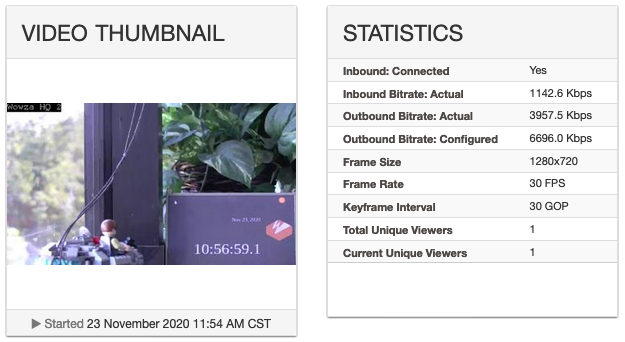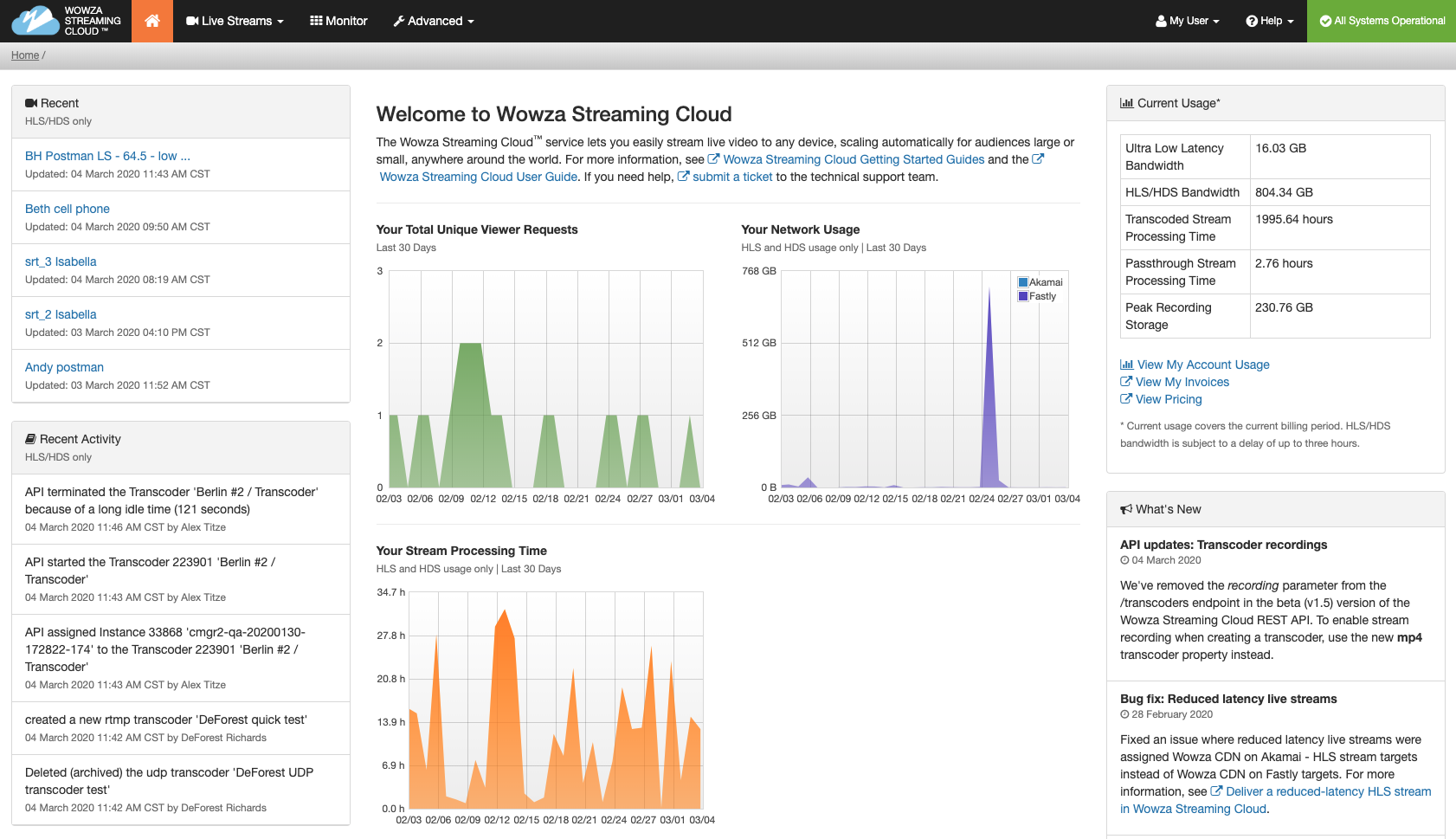Within a matter of minutes, you can set up and play your first stream on a customizable webpage hosted by Wowza Streaming Cloud™.
Wowza Streaming Cloud lets you easily stream live video to any device, scaling automatically to accommodate audiences of any size, anywhere. Wowza Streaming Cloud accepts video from nearly any encoder or IP camera, transcodes that video in the cloud, and delivers a high-quality stream in multiple bitrates that can be watched in a customizable player on virtually any device.
This tutorial walks you through using Wowza Streaming Cloud to deliver a stream from a video source to a player on a hosted page. You'll use a camera to capture a video stream that's pushed to the Wowza Streaming Cloud service for processing, and then the highest quality stream for each viewer's bandwidth is delivered to the player. Wowza Streaming Cloud handles the entire streaming and viewing experience.
Video tutorial: Get started with Wowza Streaming Cloud
See how to get started with live streaming using the Wowza Streaming Cloud user interface.
Before you start
You should have access to the following items:
- A Wowza Streaming Cloud account or a free trial account.
- A video source (camera or encoder). This tutorial uses OBS Studio as an encoder to send an RTMP stream to Wowza Streaming Cloud. For more information about OBS Studio and to download the application, visit the OBS website.
1. Sign in to Wowza Streaming Cloud
You can sign in to Wowza Streaming Cloud using any modern web browser that supports HTML5 and Cascading Style Sheets level 3 (CSS 3). The Wowza Streaming Cloud user interface has been most extensively tested on Google Chrome, however, so for best results we recommend that you use the latest version of Google Chrome.
- Access Wowza Streaming Cloud:
- Click Launch Wowza Streaming Cloud when you complete your purchase in the Wowza portal.
- Go to cloud.wowza.com.
- Click Launch Wowza Streaming Cloud when you complete your purchase in the Wowza portal.
- Sign in using your Wowza credentials.
- Accept the Terms of Use by clicking I accept.
Welcome to Wowza Streaming Cloud!
The Wowza Streaming Cloud home page provides recent activity information, usage data, and updates on new features and functionality. To learn more about the options available in the Wowza Streaming Cloud user interface, see the User interface reference.
Tip: On most pages you can click Show Help for details about the options that need to be configured on each page.
2. Create a live stream
The quickest way to your first broadcast is with a live stream. In Wowza Streaming Cloud, a live stream automatically handles a lot of the configuration and processing necessary to provide your stream to a global audience.
Complete the following steps to create a live stream in Wowza Streaming Cloud:
- Click Live Streams on the menu bar and then click Add Live Stream.
The following steps explain how to create a live stream to get started with streaming quickly, but for detailed information about any of live stream setup options, see the help panel in the user interface or Live Stream Setup page in Wowza Streaming Cloud.
- On the Live Stream Setup page, enter a short and descriptive name for the stream.
- Select the Broadcast Location that's closest to the video source and supports the features you want to use. This location is where Wowza Streaming Cloud transcodes your stream. By default, the broadcast location is based on your browser's time zone.
Note: All broadcast locations support pay-as-you-go billing and adaptive bitrate transcoding. 24x7 billing, passthrough transcoding, and 4K streaming, however, aren't universally supported. See the tags on the Broadcast Location tiles to help you select a location that supports the features you want to use, and see Wowza Streaming Cloud broadcast location features to compare feature availability at different locations.
- Click Next.
Now, Wowza Streaming Cloud needs information about the camera or encoder you're using and how to process the live stream.

- Select Other RTMP as your camera or encoder because you're using OBS Studio for this tutorial.
Depending on the video source, you have different options to further configure how Wowza Streaming Cloud processes the live stream. For the purposes of this tutorial, you can leave some of the default video source and transcoder settings and just specify the following details.
- If you have a 24x7 subscription, choose whether you want to run the stream in Pay as you go or 24x7 billing mode.
- If your subscription and broadcast location support passthrough streaming, choose whether you want the stream to be Adaptive bitrate (default) or Passthrough.
If you choose Passthrough as your live stream type, Wowza Streaming Cloud does not create adaptive bitrate renditions based on the video source's aspect ratio.
- Select a predefined Aspect Ratio and pixel dimensions, or frame size, for the resolution of the source video from the menu or manually enter it.
Note: Choosing the correct aspect ratio and dimensions ensures that the video won't be distorted, squeezed, or cropped when it's played. The aspect ratio of widescreen, high-definition (HD) video is 16 divided by 9, or 16:9. The aspect ratio of standard-definition video is 4 divided by 3, or 4:3. Full HD video is 16:9 with a frame size of 1280 x 720 pixels.
The higher the resolution of the incoming video, the more bitrate renditions Wowza Streaming Cloud generates. A bitrate rendition is a version of the live stream at a specific frame size and bitrate. Wowza Streaming Cloud automatically creates multiple bitrate renditions, based on the resolution of the source video, to offer the best possible playback experience for a viewer's device and bandwidth.
- Click Next.
You can now choose which Wowza Streaming Cloud HLS player to use and optionally configure additional details like the player width (responsive or fixed) and whether to include a poster image, countdown clock, or logo.

Note: If you use your own player, the playback settings are disregarded.
- Confirm that Original HTML 5 player (default) is selected as the player to use.
For the purposes of this tutorial, you can leave the remaining playback settings as is (default).
- Click Next.
Now, you can specify whether you want to create a webpage hosted by Wowza Streaming Cloud that plays your video.

- Select Yes to have Wowza Streaming Cloud host a webpage with the video player.
Note: You can't create a hosted page after adding the the live stream. If you don't use a hosted Wowza Streaming Cloud page, you can either embed the player on your own webpage or use your own player. When you finish creating the live stream, Wowza Streaming Cloud provides you with the embed code and playback URLs you need for those playback methods on the Overview tab for your live stream.
- Enter a short, descriptive title that appears above the player. HTML, JavaScript, and other tags aren't allowed. If you leave this field empty, Wowza Streaming Cloud uses the live stream's name as the page title.
For the purposes of this tutorial, you can leave the remaining hosted page settings as is (default).
- Click Next.
Now all you need to do is review your live stream configuration before you create it.

- Review your choices and, if necessary, click Back or on the setting pages to edit your selections.
- Click Finish to create the live stream.
Wowza Streaming Cloud opens the live stream details page for your stream.

After creating a live stream in Wowza Streaming Cloud to receive the video source, you can configure your OBS Studio as your video source so it can connect to Wowza Streaming Cloud.
3. Configure your video source
When you create a live stream, Wowza Streaming Cloud generates some information that you use to send a video source to the live stream for processing. In this case, you enter this information in OBS Studio.
- In Wowza Streaming Cloud, on the Overview tab for your live stream, locate the Source Connection Information section.
You use the information in this section to configure OBS Studio in the following steps.
- Start OBS Studio.
- Click Settings.
- On the Stream tab, for Service, select Custom.
- Enter the Primary Server for your live stream in the Server field.
- Enter the Stream Name for your live stream in the Stream Key field.
- Select Use authentication and enter the Source Username and Source Password for your live stream.
- Click OK.
Note: For more information about configuring OBS Studio, see the OBS Studio documentation.
Now that you've configured your video source, you'll start the live stream in Wowza Streaming Cloud first so it's ready to process the incoming video, then you'll start the stream from OBS Studio.
4. Start streaming
Let's start streaming!
- In Wowza Streaming Cloud, on the Overview tab for your live stream, click Start Live Stream and then click Start to confirm.
It might take a minute for the live stream to start.
- After the live stream in Wowza Streaming Cloud has started, in OBS Studio, click Start Streaming.
When Wowza Streaming Cloud receives the stream, the Video Thumbnail appears on the live stream detail page.

The thumbnail from the live stream updates every five seconds. Below the thumbnail, a date/time stamp indicates when the stream began. Connection, transcoding, and delivery metrics appear in the Statistics panel. - Click the Hosted Page URL to open it and then click play to view your live stream.

You can also share the hosted page URL with anyone else so they can watch too.
- When you're done streaming, in Wowza Streaming Cloud, click Stop Stream at the top of the live stream page. Then stop the stream in OBS Studio.
Important: Transcoding charges accrue for live streams started in Wowza Streaming Cloud even if they aren't actively streaming content. Wowza Streaming Cloud automatically stops idle live streams after 20 minutes, but you should stop your stream as soon as your event ends to avoid accruing unnecessary charges.
You've completed your first live stream! You used an encoder (OBS Studio) to send video to Wowza Streaming Cloud where it was processed and then delivered to viewers.
Next steps
You can now move on to learn how to deliver live streams to additional destinations, get useful information about your streams by reviewing stream health metrics, or configure additional live stream or transcoding settings to build a robust streaming solution.
- Deliver streams to players and targets
- View stream health metrics in Wowza Streaming Cloud
- Work with streams and transcoders







